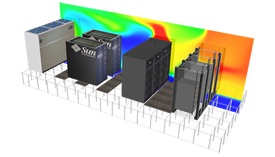

Data centre management firm nlyte Software is using Future Facilities to apply the science of fluid dynamics to air-flow and cooling in data centres.
The pair are integrating computational fluid dynamics (CFD) tools from Future with nlyte’s data centre infrastructure management (DCIM) software to simulate the air flowing through the data centre, and integrate the resultant cooling into the process of capacity planning.
The bi-directional integration of the data centre monitoring provider’s DCIM suite and Future Facilities’ 6SigmaDC suite of CFD tools has been designed to add simulation-based cooling capacity information into intelligent capacity planning processes.
But such things, when fully applied are “nearing their limits” according to experts. The next step could be to look more closely at the temperature distribution and air flow within the racks, and fluid dynamics could be one way to do this.
The CFD abilities provided by Future’s 6SigmaDC suite of tools will allow customers to automatically populate a ‘Virtual Facility’ model of their data centre and calculate the available cooling for each rack or unit of IT equipment based on the overall airflow within the data centre, the company said.
An updated set of recommended cooling limits for each rack can then be automatically exported from the Virtual Facility model and populated into the nlyte system. This in turn sets the nlyte operational systems rules for moves, adds and changes.
The combined solution enables “a proactive approach for identifying potential hot spots within the data centre, while providing increased airflow management to reclaim stranded cooling capacity,” according to the launch information.
“This combined solution will help data centre and facilities managers predict and minimise the risk of thermal failure, and save on overall data centre energy costs,” added Jon Temple, president and chief executive of nlyte Software.
A recent note by Rakesh Kumar, research vice president with analyst firm Gartner suggested that CFD analysis could provide many benefits, such as detecting hot spots, determining how the IT equipment should be configured and laid out, and predicting how much cooling capacity is left in a site. “In simple terms, a well-conducted CFD analysis will reveal how effective cooling is around the whole data centre, and around each piece of IT equipment at that moment in time,” he wrote.
OpenAI chief operating officer Brad Lightcap to oversee international expansion as company consolidates lead in…
Chinese researchers publish details on device that could wreak havoc on undersea communications cables in…
Former Intel chief Gelsinger expands role at Gloo, becoming executive chairman and head of technology…
MEPs add to Commission pressure for second EU Chips Act amidst industry calls for renewed…
Smartphone maker Xiaomi reportedly raises about $5.5bn in Hong Kong share sale as it invests…
BYD's Qin L EV sedan starts at about half the price of Tesla's Model 3,…